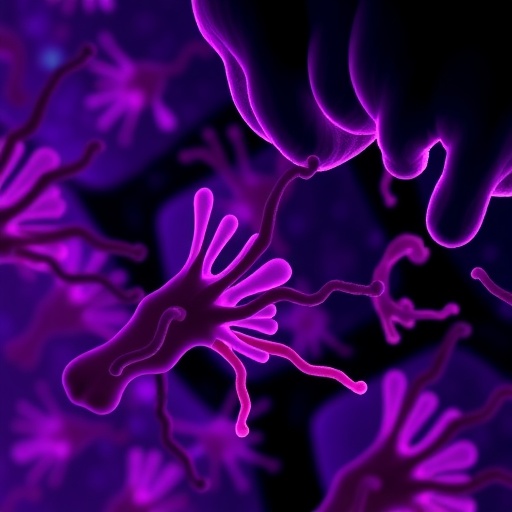In a groundbreaking study poised to reshape our understanding of intracellular heme trafficking, researchers have uncovered the molecular underpinnings governing heme allocation within eukaryotic cells, spotlighting a critical mitochondrial export mechanism mediated by the FLVCR1b transporter. This landmark investigation reveals that heme, a vital metalloprotein cofactor essential for myriad cellular functions, is exported from the mitochondria and subsequently transferred to cytosolic GAPDH, overturning previously held paradigms about heme distribution and challenging long-standing assumptions regarding its intracellular logistics.
Heme, an iron-containing porphyrin crucial for oxygen transport, electron transfer, and cellular respiration, is synthesized predominantly within the mitochondrial matrix. Despite its fundamental role, the mechanisms facilitating its transit from the site of synthesis to diverse cellular locales have remained largely enigmatic. The study authored by Jayaram et al. presents compelling biochemical and genetic evidence that the mitochondrial heme exporter FLVCR1b acts as a pivotal conduit, enabling heme egress from mitochondria to the cytosol, where it is promptly associated with glyceraldehyde-3-phosphate dehydrogenase (GAPDH). The choice of GAPDH as a cytosolic heme-binding partner adds an unexpected twist given its classical role as a glycolytic enzyme, showcasing the multifunctional nature of this well-studied protein.
Delving deeper into the molecular mechanisms, the researchers employed a sophisticated combination of gene knockout models, fluorescence-based heme sensors, and co-immunoprecipitation assays to delineate the FLVCR1b-dependent export pathway. Their data illuminate that FLVCR1b is indispensable for maintaining cellular heme homeostasis. Without its function, heme accumulates within the mitochondria, triggering oxidative stress and impairing cellular respiration, underlining the physiological importance of efficient heme trafficking mechanisms.
Moreover, the intricate interaction profile between FLVCR1b and cytosolic GAPDH emerged as a crucial nexus in intracellular heme allocation. Beyond its canonical metabolic duties, GAPDH acts as a reservoir and carrier, safeguarding heme from cytosolic degradation or aberrant reactions, thereby facilitating its targeted delivery to hemoproteins situated in various subcellular compartments. This dual functionality accentuates the adaptive versatility of cellular proteins to multitask under tightly regulated cellular environments.
This study also contextualizes the mitochondrial export of heme in relation to cellular iron regulation and redox balance. The findings suggest that the FLVCR1b-GAPDH axis may act as a fail-safe mechanism to buffer potential heme-induced cytotoxicity by balancing the concentration of free heme—a molecule notorious for catalyzing harmful reactive oxygen species formation—within critical cellular domains. Given that dysregulated heme metabolism is implicated in a spectrum of pathological states ranging from anemia to neurodegenerative diseases, these insights bear far-reaching implications for therapeutic intervention strategies.
Intriguingly, the identification of FLVCR1b as a mitochondrial heme exporter builds upon prior knowledge of its paralog FLVCR1a, previously characterized primarily as a plasma membrane heme exporter responsible for cellular heme efflux. The study clarifies the subcellular compartmentalization of these related transporters, assigning discrete roles in cellular heme homeostasis that operate at distinct interfaces—mitochondrial and plasma membranes respectively. This spatial segregation underscores the elegant specificity with which cells orchestrate heme trafficking along optimized routes.
Experimental interrogation of FLVCR1b-deficient cells divulged pronounced phenotypes marked by mitochondrial heme retention, diminished activity of cytosolic hemoproteins, and increased susceptibility to oxidative damage. Restoration of FLVCR1b expression reversed these abnormalities, consolidating its functional indispensability. These compelling observations bridge molecular transport mechanisms with broader cellular physiology, emphasizing the criticality of heme mobilization for maintaining metabolic and redox equilibrium.
Further biochemical analyses revealed that GAPDH’s heme-binding affinity is modulated dynamically in response to cellular metabolic states, suggesting potential regulatory cross-talk mechanisms whereby glycolytic flux may influence heme trafficking. This fascinating interplay between metabolism and metalloprotein cofactor allocation opens new avenues for research exploring metabolic control of intracellular cofactor distribution and its impact on cell fate decisions.
The revelation that GAPDH serves as a cytosolic heme chaperone also prompts re-evaluation of canonical protein functions, heralding a paradigm shift in cellular biology. Multifunctionality of metabolic enzymes, especially in cofactor handling, may represent a prevalent but under-appreciated theme, particularly in contexts where rapid response to environmental and metabolic stressors is essential for cellular survival.
At the subcellular organizational level, the FLVCR1b-driven heme export pathway helps reconcile longstanding questions regarding the physical and functional connectivity between mitochondrial biosynthetic outputs and cytosolic hemoprotein assembly. By demarcating the export step as a coupling point, the study provides a mechanistic framework connecting mitochondrial heme genesis with the biosynthesis and repair of extramitochondrial hemoproteins necessary for cellular respiration, oxidative stress response, and signal transduction.
From a translational standpoint, these findings may catalyze the development of novel pharmacological agents targeting heme trafficking components such as FLVCR1b or modulating GAPDH’s heme-binding properties. By fine-tuning intracellular heme distribution, such interventions hold promise in addressing heme-associated disorders, including porphyrias, hemolytic anemias, and mitochondrial dysfunction syndromes, thus broadening the repertoire of targeted therapies in metabolic and hematological diseases.
The implications extend even further into neurobiology, where disrupted heme metabolism has been implicated in neurodegenerative pathologies like Alzheimer’s and Parkinson’s diseases. The elucidation of mitochondrial heme export pathways suggests novel mechanistic links between mitochondrial health, heme homeostasis, and neuronal survival, potentially framing FLVCR1b and GAPDH as targets for neuroprotective strategies.
The research also prompts a reevaluation of heme’s role beyond its traditional boundaries, considering potential signaling functions mediated by dynamic transport and chaperoning mechanisms. Heme’s ability to influence gene expression, enzyme activity, and intracellular signaling pathways may be closely intertwined with its spatial and temporal distribution, now better understood through the FLVCR1b-GAPDH axis.
The study’s innovative application of interdisciplinary techniques ranging from live-cell imaging to mass spectrometry-based proteomics significantly enhances methodological toolkits for probing metalloprotein dynamics. Such advances pave the way for broader explorations into metal ion and cofactor trafficking across cellular compartments, an area historically hindered by technical challenges.
Taken together, Jayaram and colleagues’ work advances a new conceptual paradigm highlighting the critical importance of mitochondrial export in heme homeostasis and reveals a heretofore unappreciated partnership between mitochondrial transporters and metabolic enzymes in safeguarding cellular health. The scientific community now stands equipped with fresh targets and mechanistic models poised to accelerate discoveries in cellular metabolism, metal biology, and disease pathogenesis.
This study exemplifies the profound complexity and exquisite regulation underpinning essential metabolic pathways, uncovering layers of cellular sophistication previously masked by oversimplified models. Future research driven by these insights is likely to unravel further nuances in cofactor trafficking networks, emphasizing the integrative nature of cellular systems biology.
As we anticipate follow-up studies that might explore FLVCR1b’s regulation, identify additional cytosolic heme acceptors, and determine the pathway’s dynamics across different tissues and pathological states, this research marks a seminal step in decoding the molecular choreography that sustains life at a cellular level. The potential impact on biomedical science and clinical interventions underscores its groundbreaking significance, signaling a transformative leap in heme biology.
Subject of Research: Mitochondrial heme export and cytosolic heme allocation mechanisms in eukaryotic cells.
Article Title: Heme allocation in eukaryotic cells relies on mitochondrial heme export through FLVCR1b to cytosolic GAPDH.
Article References:
Jayaram, D.T., Sivaram, P., Biswas, P. et al. Heme allocation in eukaryotic cells relies on mitochondrial heme export through FLVCR1b to cytosolic GAPDH. Nat Commun 16, 7972 (2025). https://doi.org/10.1038/s41467-025-62819-2
Image Credits: AI Generated
Tags: biochemical evidence in cell biologycellular respiration and oxygen transporteukaryotic cellular logisticsFLVCR1b transporter functionGAPDH heme-binding interactionsgenetic insights into heme allocationglycolytic enzyme multifunctionalityheme as a metalloprotein cofactorheme synthesis and distributionintracellular heme traffickingmitochondrial heme export mechanismsmitochondrial roles in metabolism





